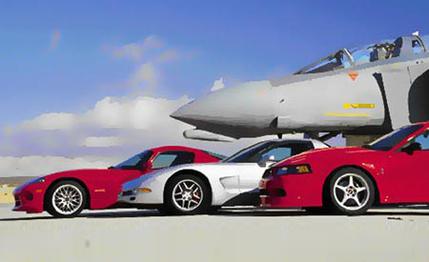 Comparison Tests
Comparison Tests


Lunch in the Lancaster In-N-Out Burger happens almost 53 years to the day after Charles E. Yeager enshrined this corner of California's high desert with the words, "There's somethin' wrong with this old machometer--it's gone kinda screwy on me."Ever since, America's steeliest pilots have come to this scrubby sandbox at the foot of the Tehachapi Mountains north of Los Angeles to scrawl a footnote in the annals of speed or test an experimental technology. Others come to probe their limits in a place where flubs are hidden in a dust cloud and don't make the "Film at 11!" Consider us in the latter department.

The Chevrolet Corvette Z06, the Dodge Viper GTS ACR, and the Ford SVT Mustang Cobra R are boyhood daydreams come to life in injection-molded plastic. They probably have the most twist, the most grip, and the most raw machismo that the lawyers of Detroit's Big Three paesanos will ever allow in a product intended for purchase by the public. Especially since the horsepower results from the very old-fashioned Yankee technique of piping as much air and fuel into the biggest holes available. Heaven surely smiles upon any company still building cars like this.
Beyond the basic formula of a big engine out front, fat driven wheels to the rear, and one very happy driver perched in the middle, the Z06, the Viper, and the Cobra R have little in common. A full $39,868 separates the cheapest from the dearest, and 75 horsepower divides the Viper from the others. The Ford has overhead cams, the Viper has 10 cylinders, and the Corvette has electronic brains that make the two others seem like four-wheeled Neanderthals.
Don't expect to see any fawning here about the sophistication of 21st-century sports cars. These machines are obnoxiously loud, their cockpits heat up in traffic like adobe ovens, and they ride as if their axles were welded to the chassis. The options sheets afford no relief as they mostly offer performance-enhancing bits and are shorter than Yasser Arafat's Hanuka gift list.
For example, the only thing Chevrolet thought our $48,920 Corvette Z06 needed--beyond its standard 385-hp LS6 V-8, titanium mufflers, and FE4 buckboard suspension--was the $26 pair of floor mats. We agree. Our only complaint is that, for now, the sweet LS6 with its freer-breathing cylinder heads and lumpier cam is only available in the hardtop. The added pounds inherent in the coupe and convertible bodies would have pushed the Z06 into gas-guzzler territory, where Corvette chief engineer Dave Hill doesn't want to go.
The Cobra R's only option was an oil-to-air differential cooler. The $1040 hand-made bauble from Ford's racing catalog stretches to new dimensions the model's track-rat schtick that was established with the second-generation Cobra R of 1995. All 250 examples of the $30,000-plus '95 model were offered only to licensed racing drivers (C/D, April 1995). Yet most ended up in air-conditioned garages with lace doilies under the tires. Ford Special Vehicle Engineering manager John Coletti insists the new Cobra Rs, which have no radios, air conditioning, or back seats, went to the first 300 people who showed up last summer with $55,675 in pocket. Hmmmph! If you're one, raise your hand.
At the risk of sounding redundant, the ACR is Dodge's extreme street Viper. The seats wear five-point racing harnesses as part of the $10,000 American Club Racing track package. The moniker doesn't refer to any series; it's just a cute label that fits Chrysler's three-letter option code for the equipment group. Ticking the ACR option box deletes the A/C and the radio, but Chrysler added those for $910, plus a $2500 pair of painted stripes, back into this test Viper. Adding luxury tax, they elevate the bottom line to a lofty $88,814. Vipers will have anti-lock brakes for 2001, but no examples were available to take into the desert.
We have encamped just miles from the front gate of Glen W. Edwards Air Force Base, the old haunt of Chuck Yeager, perhaps the best known of the '50s jet test pilots and a central figure in Tom Wolfe's The Right Stuff. The location is convenient to both the 2.5 miles of undulating asphalt at Willow Springs International Motorsports Park, the twisty public roads above Tehachapi, and the endless straightaways of the deep Mojave. We're pretty keyed up, but the periodic ka-booms, shrieks, and whooshes coming from the eastern horizon are a reminder that we don't have the fastest machines in the desert today. Not even close.